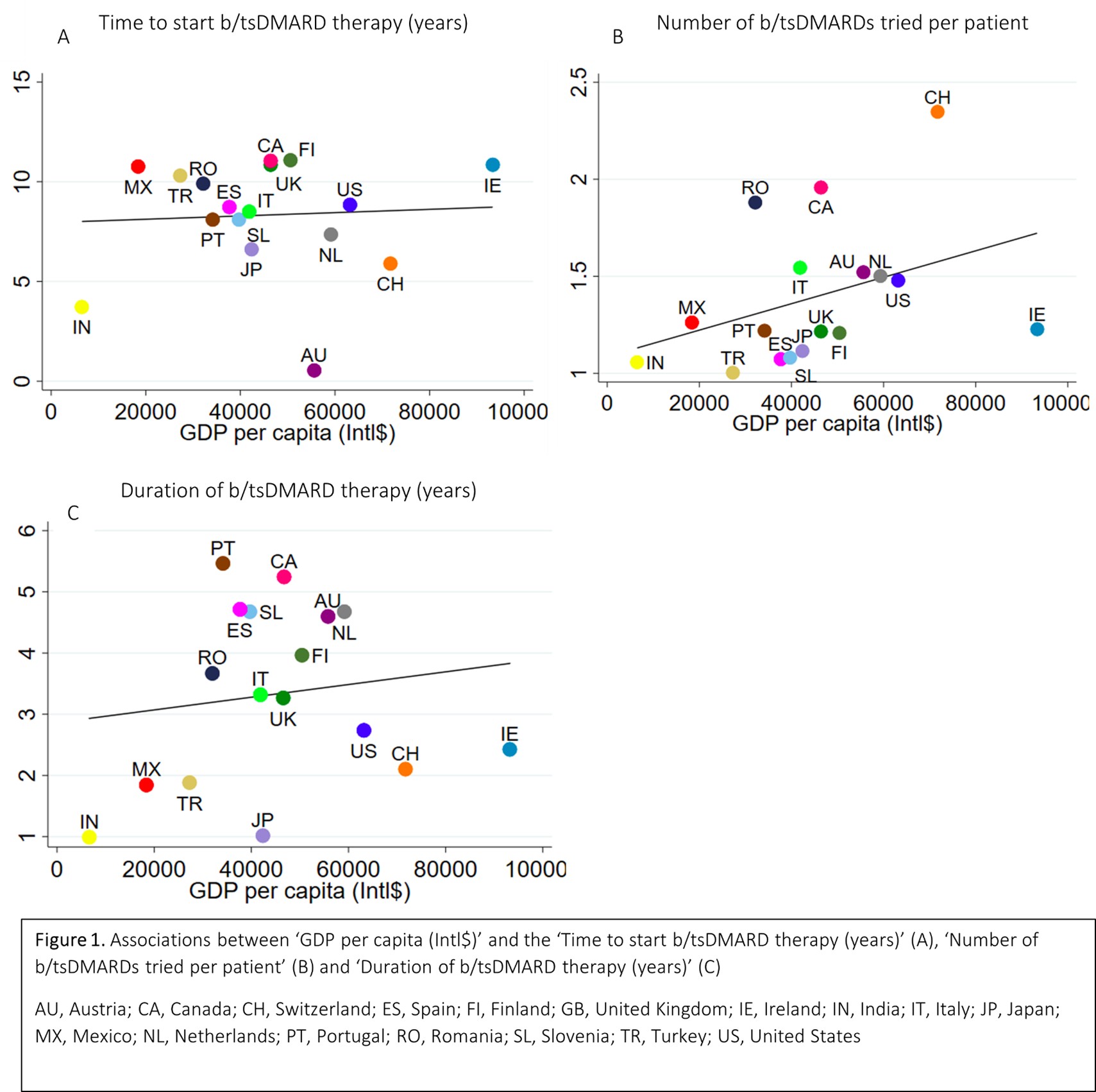Session Information
Date: Monday, November 13, 2023
Title: (1013–1032) Healthcare Disparities in Rheumatology Poster II: Socioeconomic Determinants
Session Type: Poster Session B
Session Time: 9:00AM-11:00AM
Background/Purpose: The development of biologic and targeted synthetic (b/ts)DMARDs contributed to improved treatment outcomes in rheumatoid arthritis (RA). However, high medication costs may limit their use. Previously we showed less b/tsDMARD use in countries with a lower socioeconomic status (SES), than in countries with higher SES. Here we take a more detailed look at b/tsDMARD use across countries and explore cross-country relationships between Gross Domestic Product (GDP)-per-capita, indicators of b/tsDMARD use and disease outcomes in RA-patients
Methods: This multinational, observational study included countries contributing ≥100 patients using b/tsDMARDs, with available follow-up, to one of two registries: METEOR, an international registry capturing daily practice data of patients with a clinical diagnosis of RA, and JAK-POT, an investigator-initiated collaboration between national registries aiming to evaluate clinical aspects of b/tsDMARDs in RA. On a per-country basis, mean DAS28 was calculated from the last available follow-up visit per patient. B/tsDMARD usage was determined as mean time to start b/tsDMARD therapy since date of diagnosis, number of b/tsDMARDs tried per patient and duration of b/tsDMARD therapy. To calculate the time to start a first b/tsDMARD per country included from JAK-POT, only bionaïve patients were included. Possible associations between GDP per capita, indicators of b/tsDMARD use and DAS28 were tested using univariable linear regression. Regression coefficients (β) are interpreted as the numerical increase in the outcome per one point increase in the predictor.
Results: Data from 25,832 patients from 17 different countries showed varying b/tsDMARD prescriptions. GDP-per-capita ranged from 6505 (India) to 93350 Intl$ (Ireland). Time to start b/tsDMARD therapy ranged from 0.5(Austria) to 11.1 (Finland) years. Mean number of b/tsDMARDs tried per patient ranged from 1.0 (Turkey) to 2.4 (Switzerland). Duration of b/tsDMARD therapy ranged from 0.9 (India) to 5.5 (Portugal) years (fig 1). Baseline DAS28 ranged between 3.7 and 6.1, but was not related to any of the indicators of b/tsDMARD use: time to start a b/tsDMARD β 0.08 (95% CI -0.7; 0.9), number of prescribed b/tsDMARDs β 0.06 (95% CI -0.03; 0.2), duration of b/tsDMARD treatment β 0.1 (95% CI -0.3; 0.5).No statistically significant associations were observed between GDP-per-capita and time to start b/tsDMARD therapy (fig 1A, β 0.09 CI 95% -0.7; 0.9), number of b/tsDMARDs tried per patient (fig 1B, β 0.07 CI 95% -0.02; 0.2) or duration of b/tsDMARD therapy (fig 1C, β 0.1 CI 95% -0.3; 0.5). None of the indicators of b/tsDMARD prescription were significantly related to DAS28 at the end of follow up: time to start a b/tsDMARD β 0.02 (95% CI -0.05; 0.1), duration of b/tsDMARD therapy β -0.03 (95% CI -0.2; 0.1) and number of b/tsDMARDsβ -0.03 (95% CI -0.6; 0.6).
Conclusion: This study showed varying b/tsDMARD prescription behavior and disease activity across 17 countries worldwide. Overall, differences in b/tsDMARD prescription behavior was not related to socioeconomic welfare and disease activity at a country level. This seems to indicate that once patients start a b/tsDMARD, socioeconomic welfare has less impact on b/tsDMARD use.
To cite this abstract in AMA style:
Nevins I, COURVOISIER D, Finckh A, Fritsch-Stork R, Nordstrom D, Rodrigues A, Dinescu S, Garcia A, Oztas M, Rotar Z, Salomon K, Chopra A, Vega Morales D, De Buck M, Choquette D, Conway R, Iannone F, Allaart C, Huizinga T, Lauper K, Bergstra S. Cross Country Differences in b/tsDMARD Prescription Behavior: Associations Between Socioeconomics, Real World b/tsDMARD Use and Disease Outcomes [abstract]. Arthritis Rheumatol. 2023; 75 (suppl 9). https://acrabstracts.org/abstract/cross-country-differences-in-b-tsdmard-prescription-behavior-associations-between-socioeconomics-real-world-b-tsdmard-use-and-disease-outcomes/. Accessed .« Back to ACR Convergence 2023
ACR Meeting Abstracts - https://acrabstracts.org/abstract/cross-country-differences-in-b-tsdmard-prescription-behavior-associations-between-socioeconomics-real-world-b-tsdmard-use-and-disease-outcomes/

